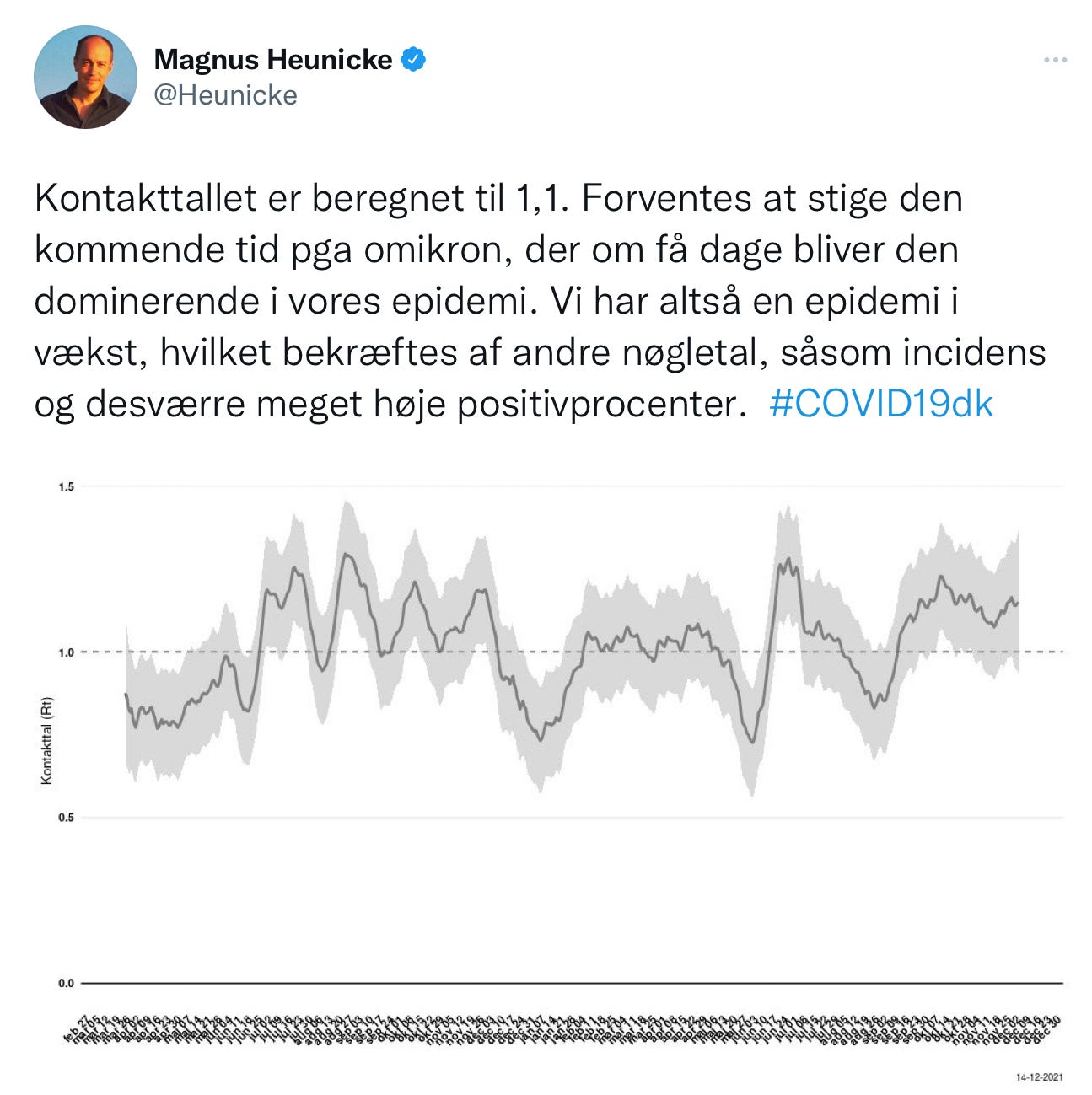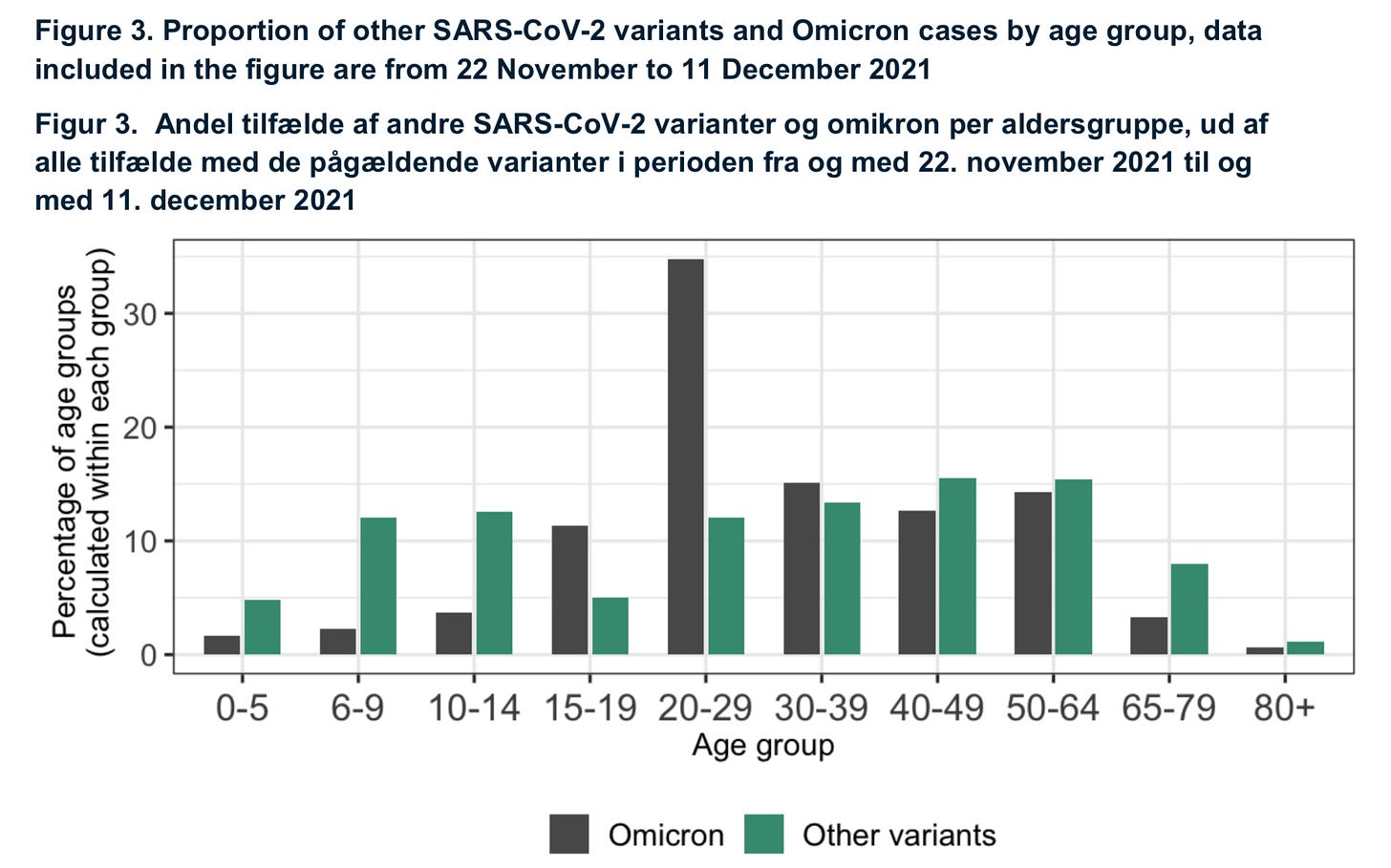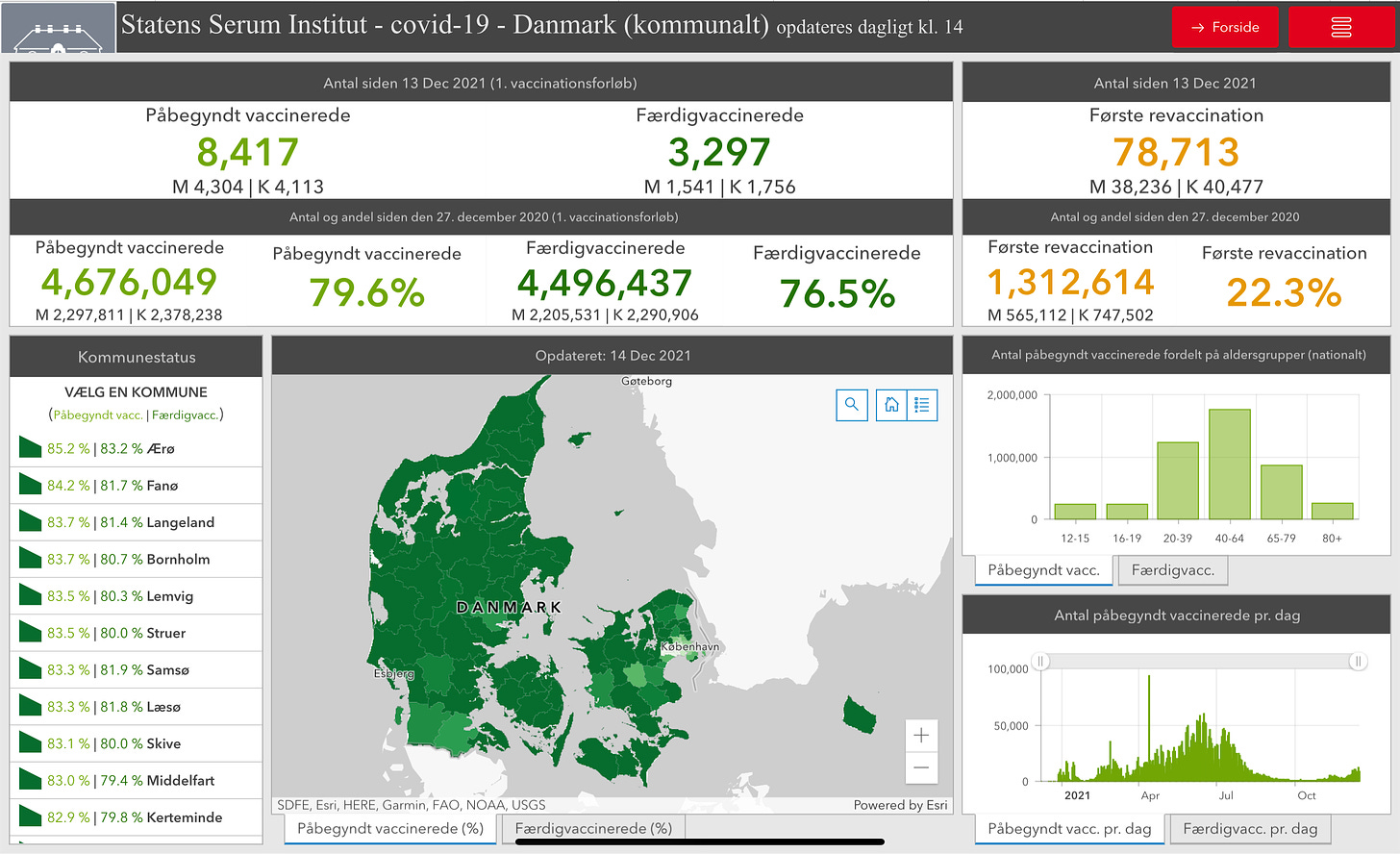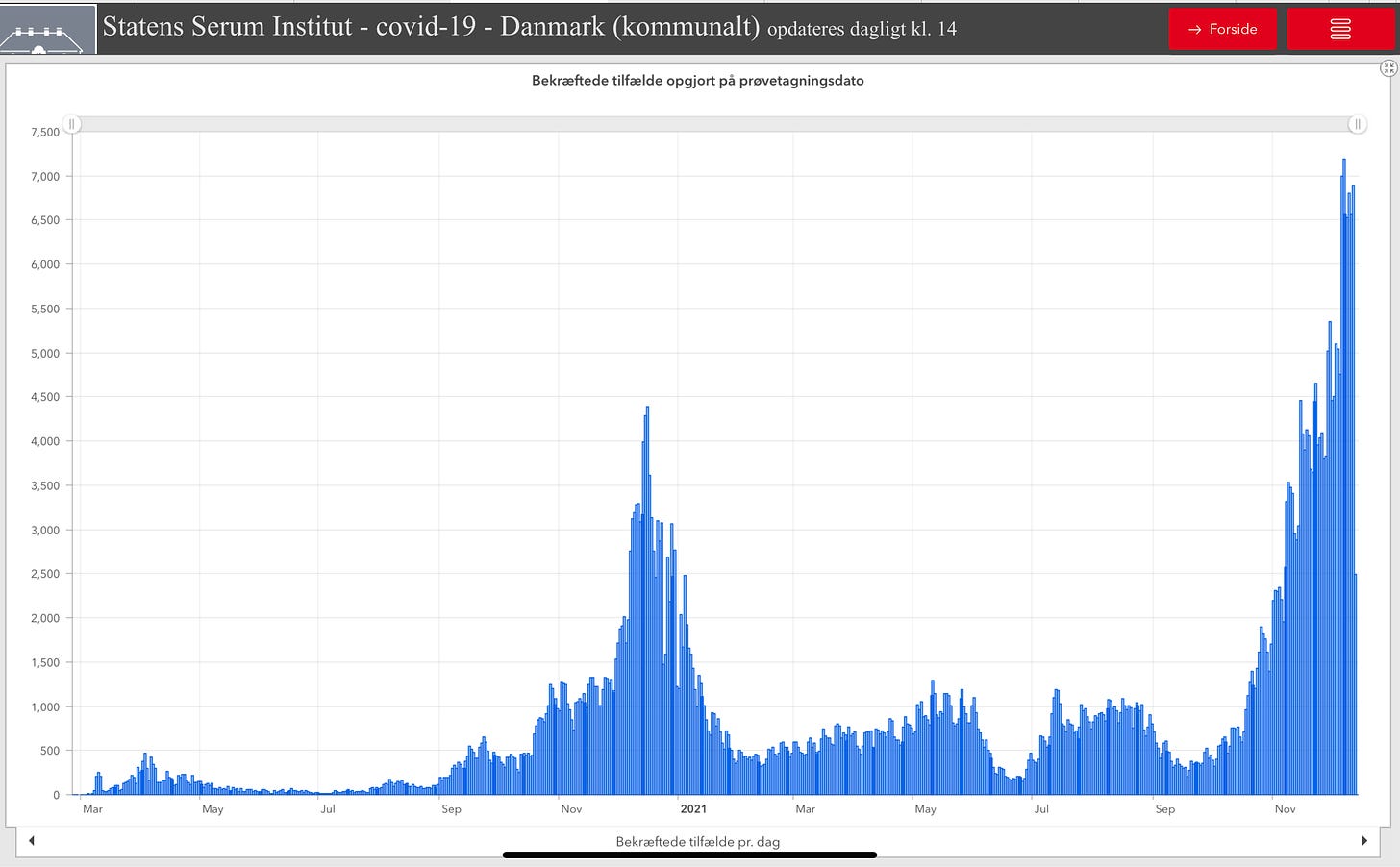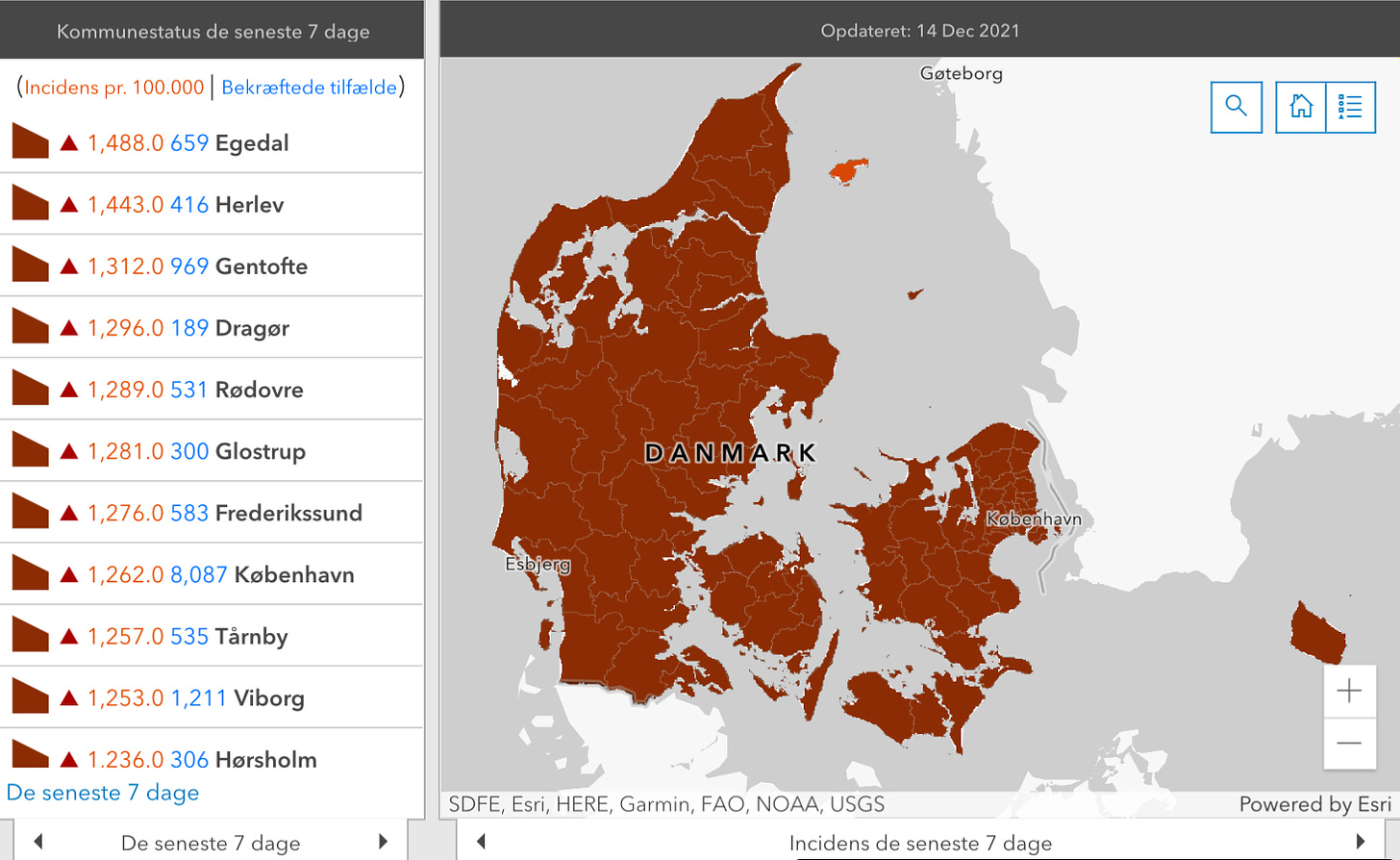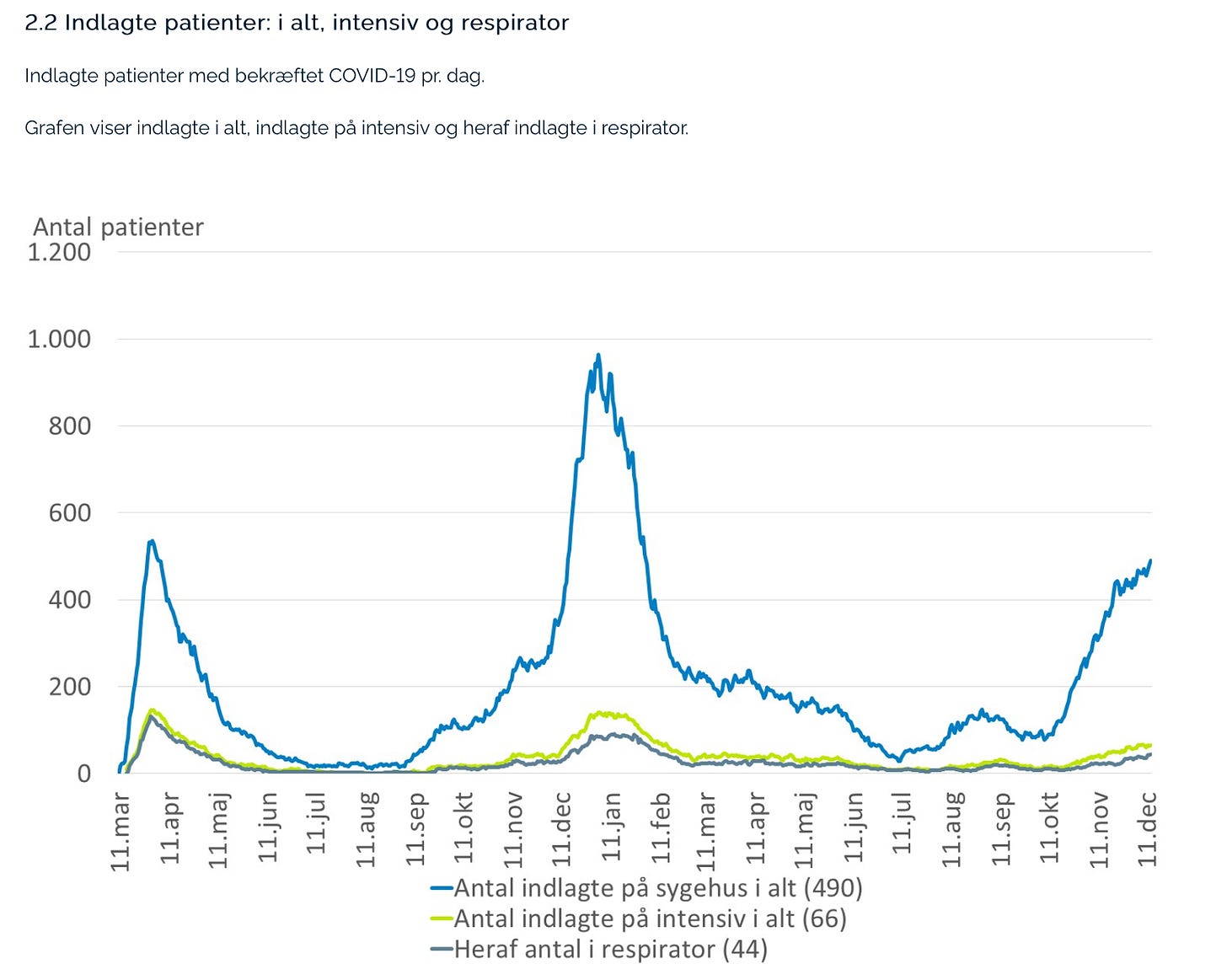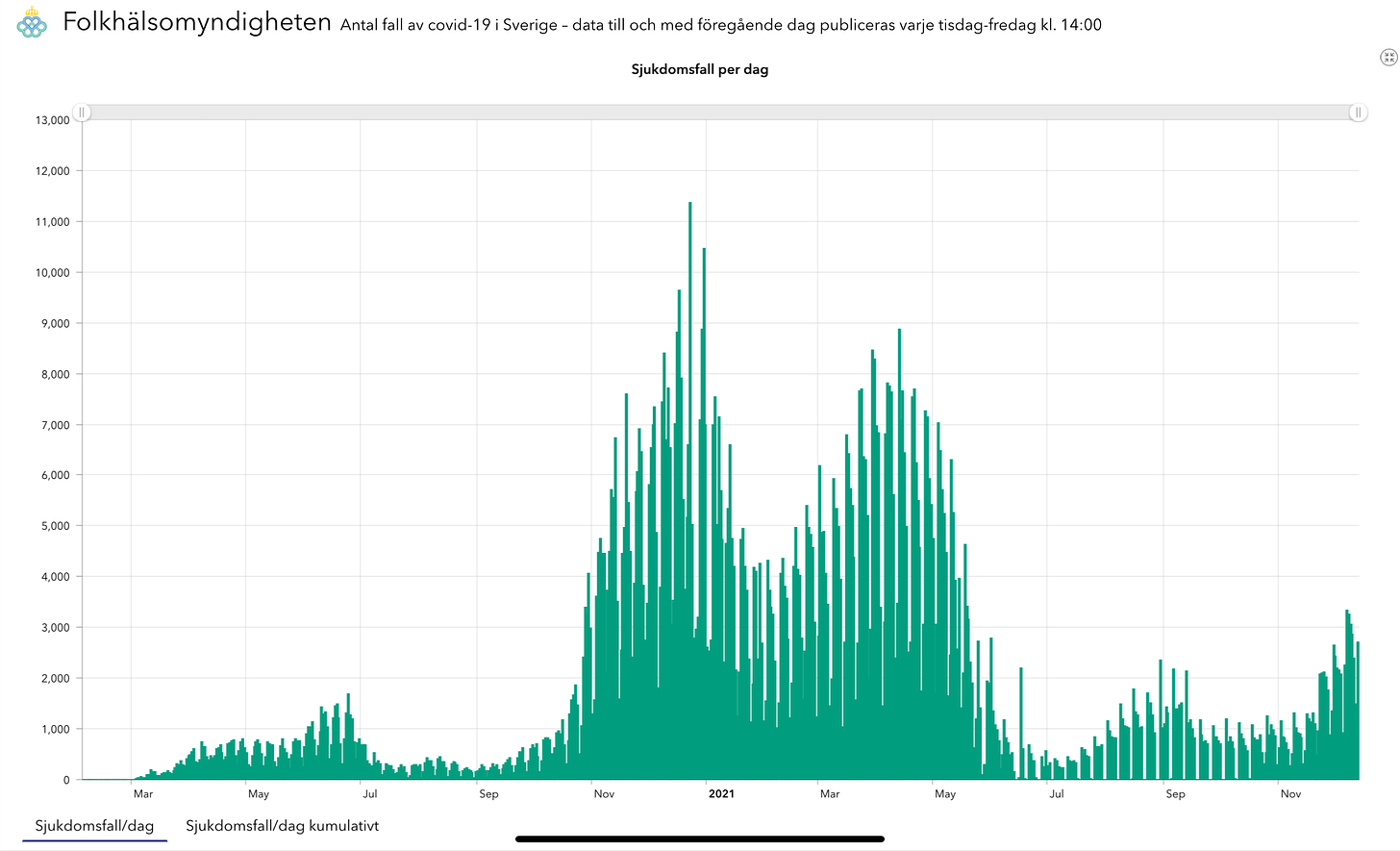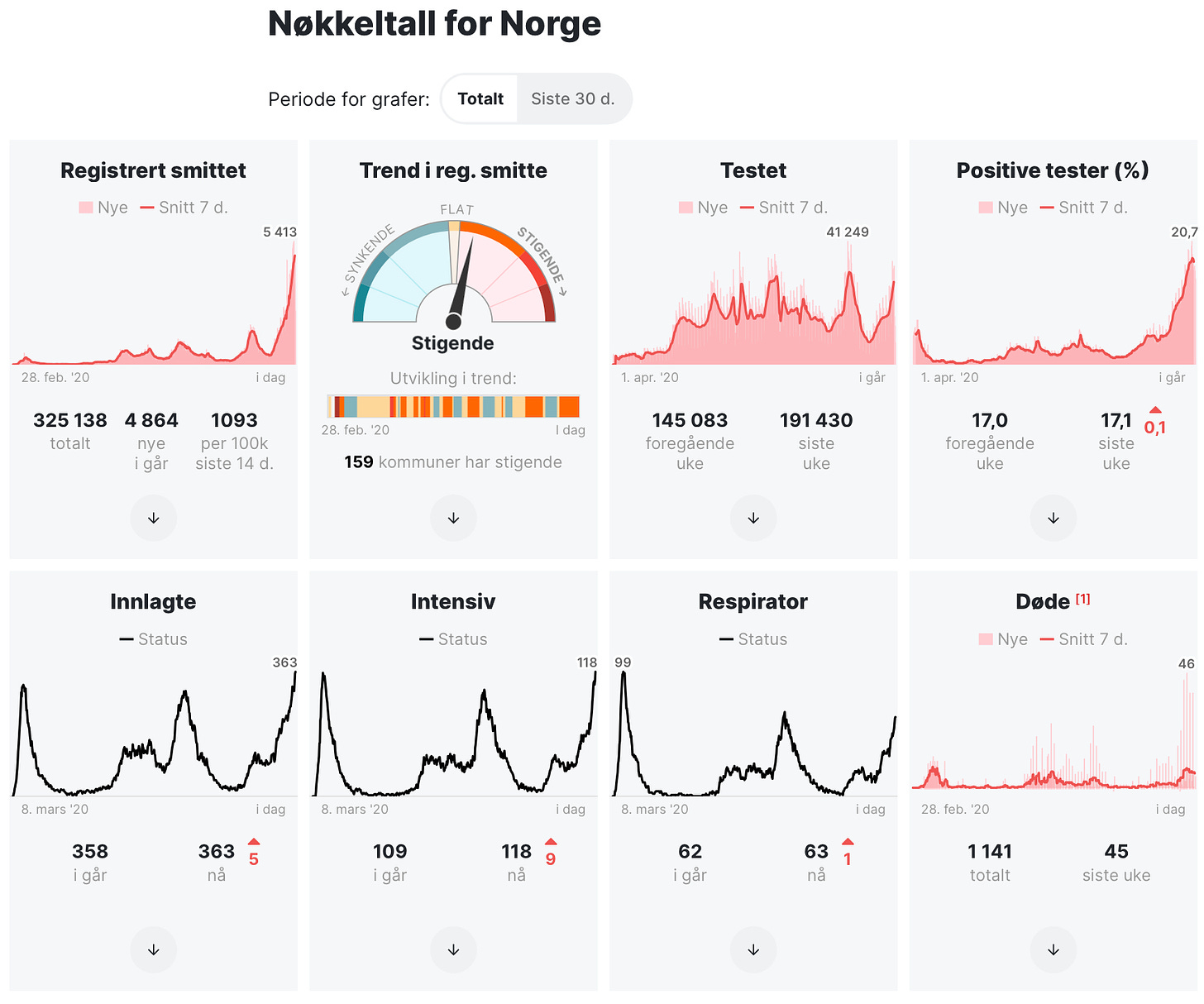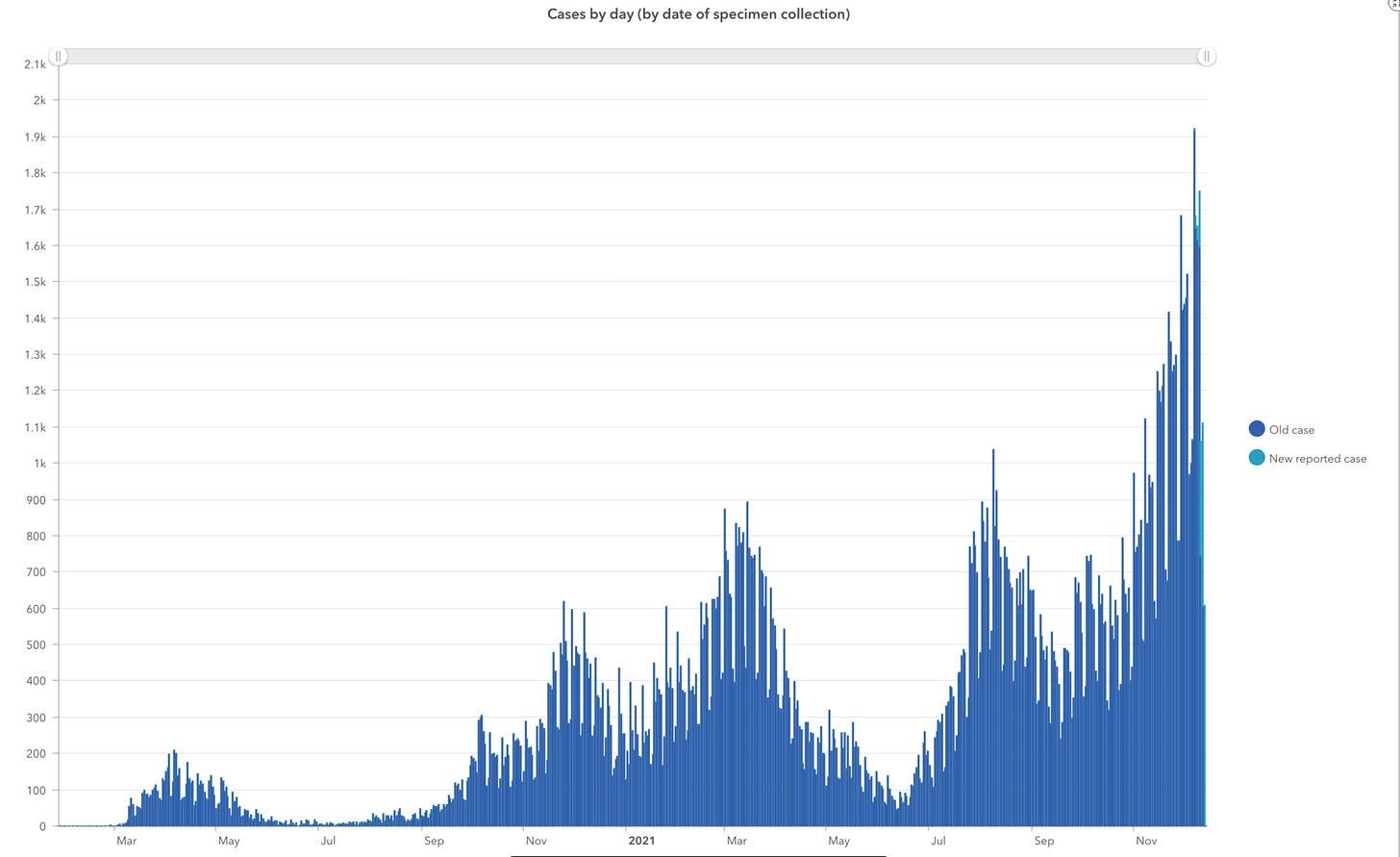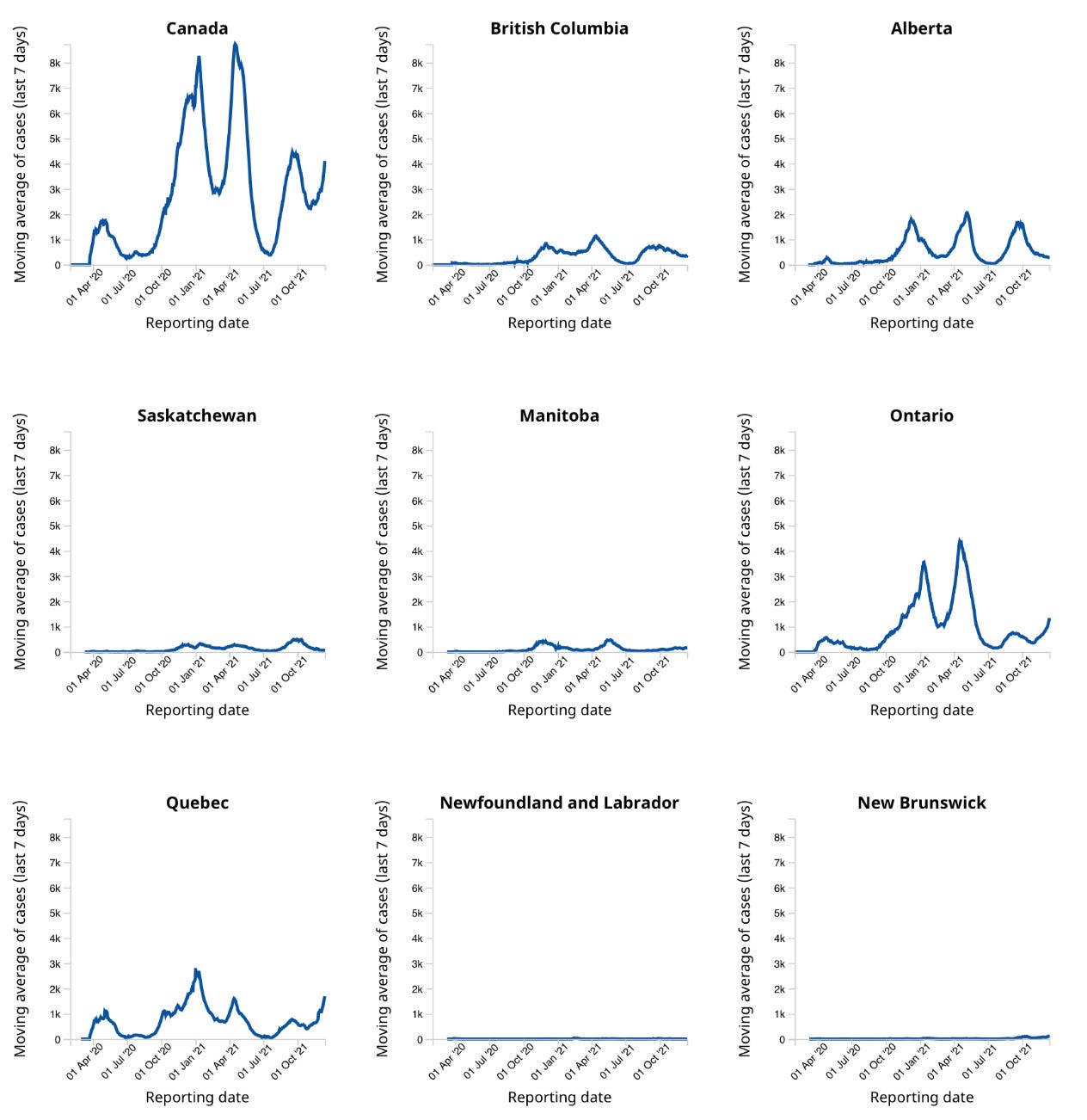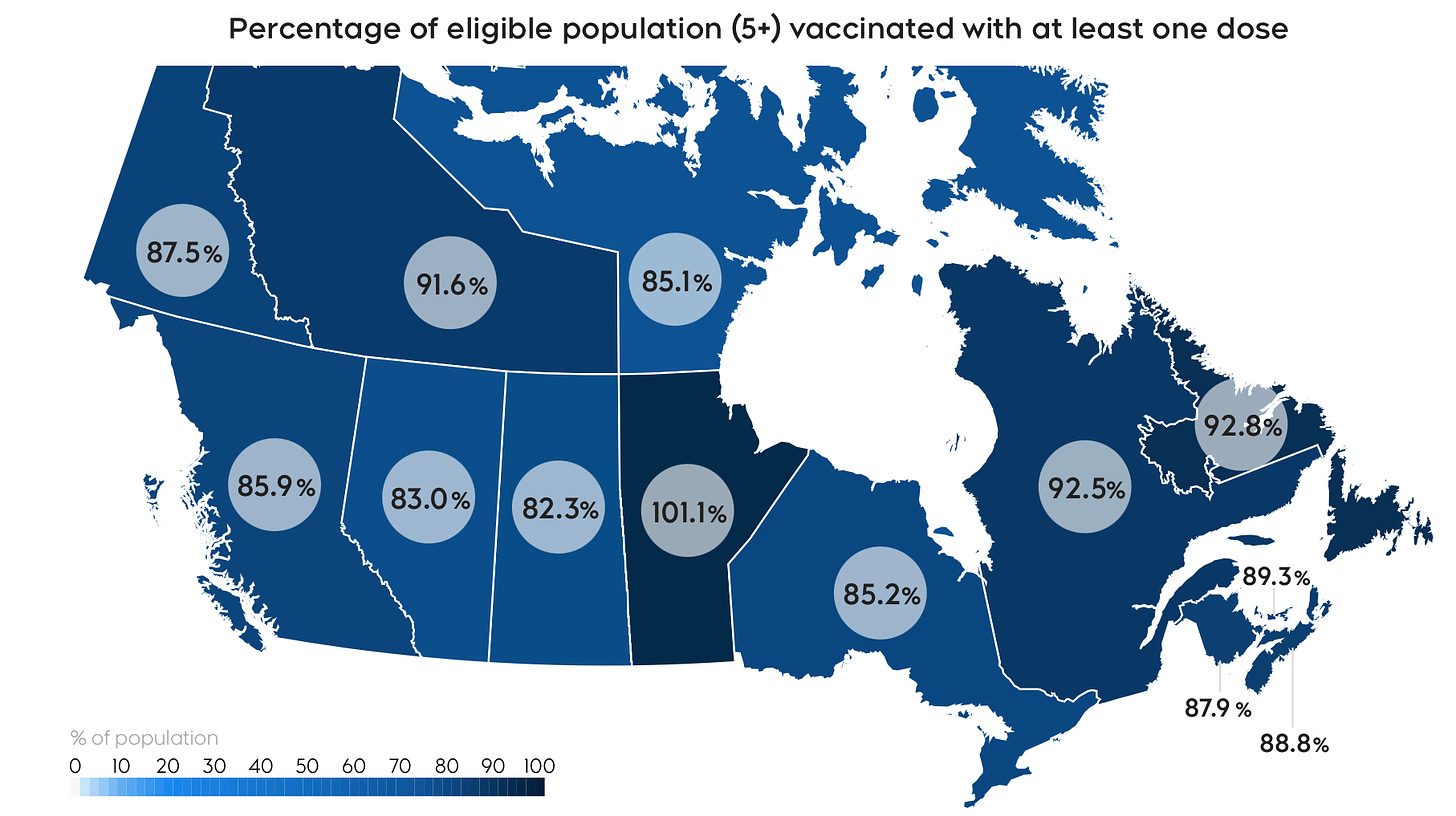The Evening Report - Dec 14
The Omicron threat has the Nordic countries going all out on booster dose vaccinations.
🇩🇰
The Staten Serum Institut has updated its risk assessment for the new Omicron variant and now says it will be dominant within Denmark’s capital region “as early as this week.” The agency says “an increasing number of infections with over 10,000 daily cases is expected in a short time.”
The SSI notes regional differences and complications like Omicron outbreaks at major events around Denmark make it difficult to forecast when it will become the dominant COVID strain outside Metro Copenhagen.
The latest SSI risk assessment finds that on top of a major potential increase in daily infections, the Omicron variant will challenge epidemic controls, testing capacity, and infection detection efforts.
Director Henrik Ullum warns that when cases go up, so will hospitalizations.
“An increasing infection spread throughout society will entail a high risk of a secondary increase in the number of admissions, especially among unvaccinated and vaccinated debilitated people.”
The risk assessment warns an Omicron wave will result in an “increasing number of [hospital] admissions” especially among the unvaccinated. It also warns of a high risk of infections spreading among vulnerable groups including healthcare workers.
“There is a high risk that a large number of hospital staff will be infected at the same time and have to be sent home.”
The good news, Ullum says, is that current vaccines are still effective, and especially if someone has had a booster dose.
“We expect that both the 2nd and especially the 3rd dose protects against serious illness from the Omicron variant. In addition, new studies from England indicate that a booster dose also provides protection against symptomatic infections. Therefore, a quick roll-out of a 3rd dose is absolutely crucial to curb both the spread of infection and especially the serious impacts that could come.”
-
Denmark’s Health Minister Magnus Heunicke says the COVID contact rate (reinfection rate or R0) in Denmark has been calculated to be 1.1 for a second straight week.
“We therefore have a growing epidemic, which is confirmed by other key figures, such as the incidence rate and unfortunately very high positivity percentages.”
Heunicke says the RO is expected to increase in the near future due to the Omicron variant. He says while the Delta variant remains dominant it won’t be for much longer as he notes Omicron growth in Metro Copenhagen is outpacing Delta by an astonishing 53% to 3% every day.
“Therefore, Omicron is expected to take over the epidemic shortly.”
The health minister says a major effort is underway to protect the population by getting as many booster doses administered in as short a time as possible.
-
The number of Omicron infections in Denmark continues to spiral upward, with the Staten Serum Institut confirming 4,535 cases of the variant in Tuesday’s report. That is 1,098 more Omicron cases than yesterday’s reported 3,437.
There have been 29 total hospitalizations related to the new variant, but currently only 15 people are in hospital.
According to Aalborg University Professor Mads Albertsen, whose team led Denmark’s COVID testing efforts, as of December 11, Omicron variant cases made up 16.7% of all new infections.
-
As of this week in Denmark anyone 40 years old and older can get a booster dose even without a vaccination invitation. The Danish National Health Board says immunity via two doses of vaccine against symptomatic infection from the Omicron variant “may be somewhat weaker.” But, it adds, the preliminary data shows a third dose offers increased immunity. So it is now pouring all of its efforts into getting a huge chunk of the adult population a booster dose.
Director Søren Brostrøm:
"We are in a serious situation due to the new and more contagious variant. Fortunately, we have already revaccinated the oldest part of the population, and now we are advancing booster doses for everyone 40 years and older 4.5 months after a 2nd dose. This way, we can have better protection this winter for those who are at increased risk and increase immunity within the population.”
Anyone born in 1981 or earlier can get a booster shot, but the health board warns that there may be some waiting times due to the crush of people trying to get vaccinated. In fact, more than 700,000 people will receive a vaccination invitation this week.
-
On the vaccination front, the booster dose surge has begin with 78,713 3rd doses administered yesterday. 8,417 people had a 1st dose.
To date, 79.6% of the total population have had one vaccine dose, 76.5% have had two, and 22.3% have had a booster dose.
As of Monday, 40,752 children aged five to 11 years old have had a 1st vaccination dose. As a percentage of the age group that equals 9.46% vaccination coverage.
-
Region Midtjylland is postponing a number of treatments and procedures as they clear the decks to deal with COVID patients and to free up staff in order to go all out on administering booster doses. The region needs more manpower to get people vaccinated as Denmark as a whole rushes to administer as many booster doses as possible to increase protection against the Omicron variant. The move of staff over to vaccination sites means as of today (Tuesday) hospitals in Region Midtjylland will sharply reduce all non-essential operations.
-
It is not just hospitals Denmark’s Armed Forces are scaling back border control operations and other tasks they help police with so personnel can be freed up to help with COVID testing and vaccination efforts. The Danish Emergency Management Agency is deploying another 400 people to help the Danish regions.
This will mean taking staff away from work along the Danish-German border in Southern Jutland and some other tasks they do in concert with police in Copenhagen.
National Police Chief Inspector Peter Ekebjærg:
“This will of course mean that we have to prioritize some of the work we do in collaboration with the Armed Forces for a period of time, but we are of course looking for solutions that have the least possible impact on the citizens.”
-
A day after reporting a record high 7,799 new corona cases Denmark has set another record high with 8,314 COVID infections on Tuesday along with seven more coronavirus deaths in the last day.
Yesterday, there were 463,428 total corona tests done, of which 201,322 were PCR tests equaling a positivity percentage of a very high 4.13%.
-
All but four of Denmark’s 98 municipalities have a COVID incidence rate of 300 or more per 100,000 residents. A full 25 Danish kommunes now have an incidence rate of 1,000 or more.
-
COVID hospitalizations (498) continue to rise (+11) while the number of infected people in an ICU (70) also edged upward (+3) and of those the number on a ventilator (46) crept up as well (+2).
-
Region Syddanmark is bringing pharmacies onboard to help with the vaccination effort. The region has reached a deal with 58 pharmacies that it says will further bolster the number of weekly vaccinations by another 20,000.
Director at APOVAC Bjarne Kalø:
“It is our goal to make it quick, easy, and safe for Danes to be vaccinated against COVID at our pharmacies included in the agreement. Our staff already has extensive experience in vaccinating against influenza and pneumonia, and we also know that many citizens have already experienced being vaccinated at the pharmacy. We hope that accessibility and geographical coverage will help to ensure that more people are vaccinated. In this way, we can help support the region's vaccination efforts.”
The first pharmacies offering COVID vaccinations will come online on Thursday, with the rest to follow shortly. The pharmacies will also offer vaccinations for young children, giving parents another option.
🇸🇪
Sweden has added 9,472 infections and 13 more corona deaths since its last update on Friday.
So far, 7,682,186 1st vaccine doses (85% of the population aged 12 years old and older) and 7,289,327 2nd doses (80.7%) have been administered. Of the fully vaccinated 1,795,073 (21.6%) have a booster dose.
-
The Swedish Public Health Agency may levy new COVID restrictions as it watches the current epidemic situation. In the last week, the number of coronavirus patients in hospitals across the country has continued to mount. There are currently 395 hospitalizations up from 307 a week ago. ICU numbers have increased from 47 to 74 in the last seven days.
Director Karin Tegmark Wisell says the numbers are trending in the wrong direction, as she told Aftonbladet more restrictions may soon become necessary.
“If we see that there is a continued increase, both in terms of patient load and number of cases, we intend to reexamine the pandemic forecasts and review which restrictions may be relevant.”
-
Pressure continues to build on hospitals in Sweden’s capital region. There are now 157 COVID patients in Region Stockholm, which is 37 more patients compared to a Tuesday of last week. Of those, 20 are in intensive care.
Chief Physician Johan Bratt says the strain is building on healthcare infrastructure.
“It is currently a very tough situation for health facilities due to a high influx of COVID patients, as well as those with seasonal flu and other common diseases. Södersjukhuset, Danderyds hospital, Norrtälje hospital and St Göran hospital have all declared staffing mode.”
In Swedish, ‘stabsläge’ translating to “staff mode” is a measure allowing the hospital to prioritize staffing, care, and resources to focus on an emergency situation, in this case an influx of COVID patients.
Bratt is urging people to take precautions to protect themselves, including maintaining good hand washing practices. If they need care people should call the Swedish first contact health line (1177) to get an assessment on what care is needed.
The region says COVID testing is increasing with 72,000 tests taken and analyzed in the last week. There were 4,536 new coronavirus cases last week. A total of 22 Omicron variant infections have been confirmed so far.
“Vaccination is still the best protection against severe cases of COVID. I want to urge as many as possible to get vaccinated as soon as you have the opportunity. This reduces the risk of yourself and your loved ones becoming infected and suffering from a serious illness.”
-
Lund Kommune has officially introduced a mandate that new employees must be fully vaccinated as a condition of employment. The municipality says the requirement applies to specific jobs in health and social care. According to a report from Sydsvenskan, other municipalities in Sweden are now preparing similar mandates.
🇳🇴
Norway has added 5,282 infections and five more pandemic deaths in the last day.
COVID hospitalizations (363) have increased (+5) while the number of people in intensive care (118) have risen (+9) and of those the number on a ventilator (63) also crept upward (+1).
To date, 79% of Norwegians 12 years old and older have had one vaccine dose, 72% have had two, and of those 18.7% have had a booster dose.
-
The Norwegian Institute of Public Health has tabled a terrifying Omicron risk assessment. In it, the agency says the situation is “increasingly serious and the new variant will “soon become dominant” resulting in an increased infection spread. How increased? Its ‘preliminary scenario’ estimated that within three weeks daily COVID cases could reach between 90,000 to 300,000 infections. While hospitalizations could increase to between 50 to 200 admissions per day if measures don’t slow down the epidemic significantly.
As an added incentive for more significant COVID restrictions, the national health agency says they could also mitigate an influenza epidemic as cases there are also rising.
-
Not long after the Norwegian Institute for Public Health tabled its jaw-dropping risk assessment of the threats posed by an Omicron variant wave, significant new restrictions were announced. On Monday, Norwegian Prime Minister Jonas Gahr Støre said the COVID situation is now serious and new measures are needed to try to bring down soaring numbers.
“Infections in Norway are increasing sharply, and we have now gained new knowledge about the omicron variant and how fast it can spread. We are in a more serious situation. The government is therefore introducing stricter measures to maintain control of the pandemic. We have received clear advice from the health authorities to introduce new, stricter measures now. We are concerned with protecting children, young people and vulnerable groups, but unfortunately they will also notice the measures in their everyday lives. At the same time, we know that many who work in the health service and in schools and kindergartens are tired now. This reinforces the seriousness of the situation.”
As part of the effort to prevent Norway’s hospitals from being overwhelmed and to try and increase societal protection against the Omicron variant Norway has called in the Armed Forces to help with vaccinations. Pharmacies will also now help administer COVID vaccines. The interval between a 2nd and 3rd dose has also been reduced to 4.5 months for everyone 45 years old and older with the goal of getting them all booster doses by mid-January.
COVID restrictions
one meter social distancing in most cases and situations. Kindergarten and primary school students are exempt.
Only ten other guests are allowed in a home outside the people in the household. For Christmas and New Years the cap is increased to 20 with a one meter distancing rule for all guests.
Meet outside whenever possible
As part of reducing social contacts visiting with other people, attending events, and social gatherings must all be limited.
Public transit, especially during peak periods, should be avoided
Amusement parks, playgrounds, arcades “and the like” are closed.
Libraries, museums, shops, trade fairs, temporary markets, and shopping malls must ensure social distancing, proper hand hygiene; that spaces are properly cleaned, and have good ventilation.
Masks
Masks are mandated where ever it is not possible to keep socially distant. This includes in shops, malls, restaurants, public transport, taxis, and indoor train, ferry, and bus stations.
Masks are also mandated for employees who cannot be socially distant or are not separated by physical barriers.
Hairdressers, dermatologists, tattoo artists and any other profession requiring close contact are to wear masks, as are their customers.
Masks are also now mandated at indoor events, in libraries, and in museums.
Sports
Indoor sports and activities are capped at 20 people even for kindergarten and primary school students unless everyone involved is from the same cohort or class.
Sporting games, matches, and tournaments bringing together people from different places should be cancelled.
Indoor leisure activities and sports where people, including children, cannot keep one-meter socially distant should not be played. Anything outdoors with social distancing is fine.
Swimming pools, water parks, spas, hotel pools, and gyms can operate as long as they ensure social distancing, good hygiene, proper cleaning, and ventilation. For any Lehigh intensity” training social distancing is extended to two meters.
Schools
The COVID alert level has been moved to ‘yellow’ for all kindergartens, primary schools, and lower-secondary schools.
For upper-secondary schools and adult education, the COVID alert level is now ‘red.’
Universities, colleges, and vocational colleges should all move classes and skills training online as much as possible.
Work life
Everyone who possibly can should work from home
Employees physically at work must be able to work with one meter social distancing and if distancing cannot be ensured face masks must be worn.
Indoor spaces where people have to spend time at work, etc. should be well ventilated.
Events and gatherings
Private indoor gatherings in a borrowed or rented public space are capped at 20 attendees. For outdoor events, the cap is 50.
Indoor public events are capped at 20 without seating and 50 with ‘fixed allocated seating.’ Outdoor public events are capped at 100 without seating and three separate cohorts of 200 each with seating.
Memorials and burials can have no more than 50 people attending. The funeral itself is considered a public event with the rules (above) applying.
Event organizers must ensure social distancing.
Alcohol sales are banned at licensed events, be they indoors or outdoors.
Masks are required at all indoor events.
Restaurants
Alcohol sales are banned in all licensed establishments.
There must be one meter social distancing between guests and tables.
Masks are to be worn when standing or moving within a restaurant.
Activities involving close contact like dancing are banned.
Restaurants must register contact information for all customers “who consent to it” and must have basic infection control measures in place.
🇫🇮
Finland has registered 1,676 infections and another two virus deaths since yesterday’s update.
To date, 76.9% of the total population have had one vaccine dose, 72.9% have had two, and of those 9.7% have had a booster dose.
-
The Finnish Institute for Health says the first shipments of the special pediatric Pfizer/BioNTech vaccine doses will arrive in Finland this week. That means the vaccination effort for children five to 11 years old who are considered at risk will begin this week. Institut Chief Specialist Mia Konto said the first shipment should contain 162,000 pediatric doses with another 78,000 to follow early in the new year.
-
At least one Finnish health expert thinks the Omicron variant will be dominant in Finland within a week. Helsinki and Uusimaa Diagnostics Director Lasse Lehtonen says the indications are the variant is widespread in Finland’s most populous region. Lehtonen told YLE that testing results are increasingly showing a marker indicative of the Omicron variant.
“The development appears very similar to the ones seen in Denmark and Norway. We may be a few days behind, but it is very likely that Omicron will now spread to the [Finnish] population.”
Pathology Researcher Tuomas Aivelo concurs and is predicting the new variant will become the dominant corona strain by Christmas.
“If the share of test results was 7% last week, the readings are much higher now. In a week, Omicron will be the main variant in the HUS area and elsewhere.”
While the other Nordic countries go full tilt on getting eligible populations a booster dose to increase societal protection against Omicron, Finland has not yet done so.
🦠🌍
The World Health Organization is again sounding the alarm over vaccination inequity as wealthier western nations begin madly administering booster doses to fend off the Omicron variant.
WHO Director General Dr Tedros Adhanom Ghebreyesus in a Tuesday COVID briefing, said there is a “vast gap” in vaccination rates between countries. He said 41 countries still have not managed to vaccinate 10% of their populations and 98 countries have yet to reach 40% vaccination coverage.
“Most countries are using COVID vaccines as fast as they get them. A small group of countries are facing challenges rolling out vaccines and scaling up rapidly, and WHO and our partners are working closely with those countries to overcome bottlenecks. WHO is concerned that such programmes will repeat the vaccine hoarding we saw this year, and exacerbate inequity. It’s clear that as we move forward, boosters could play an important role, especially for those at the highest risk of severe disease and death. If we end inequity, we end the pandemic. If we allow inequity to continue, we allow the pandemic to continue.”
That said, Dr. Tedros did voice concerns about the rapidly spreading Omicron variant.
“77 countries have now reported cases of Omicron, and the reality is that Omicron is probably in most countries, even if it hasn’t been detected yet. Omicron is spreading at a rate we have not seen with any previous variant. We’re concerned that people are dismissing Omicron as mild. Surely, we have learned by now that we underestimate this virus at our peril. Even if Omicron does cause less severe disease, the sheer number of cases could once again overwhelm unprepared health systems.”
He says vaccines alone are not the solution to getting out of this crisis; countries must use all the restrictions in their toolbox that we know work to prevent infection spread. If they work against the Delta variant, they will work against Omicron.
On the good news front, Dr. Tedros says the international COVAX initiative helping to get vaccines to developing countries has shipped more doses in the past ten weeks than it has in the first nine months of the year.
🇨🇦
Canada reported 4,233 new infections on Monday, along with another 15 coronavirus deaths. Nationally, the infection curve is shooting upward, driven by rising numbers in both Ontario and Quebec.
On the vaccination front to date, 31,671,952 1st vaccine doses (82.83% of the total population) have been administered while 29,204,478 people (76.38%) are fully vaccinated and of those 2,500,142 people have had a booster dose.
In Ontario Tuesday, there were 1,429 COVID cases, of which 526 were people with one vaccine dose or none at all. There were also five more deaths. There are 385 people in hospital and 300 of them are partially vaccinated or unvaccinated. For the 162 people in an ICU, that number 131.
Quebec has yet to report on Tuesday but did log 1,747 COVID cases and three more deaths on Monday. The province is asking people to work from home and has rolled out millions of rapid tests as it faces the Omicron threat.
In Atlantic Canada, Nova Scotia recorded 127 new infections New Brunswick had 109. Newfoundland and Labrador had 15.
Manitoba saw 164 new corona cases and two more deaths on Tuesday.
There were 35 new infections in Saskatchewan on Monday and for a fourth day in a row, no new deaths.
Alberta logged 1,129 new COVID cases and three more deaths from Friday through Sunday. The province has confirmed seven more Omicron variant infections for 30 total. There are 185 people in hospital and of those 72 are in intensive care.
B.C. registered 1,129 infections and five more deaths over a three day period covering the weekend. There are 185 people hospitalized of which 72 are in an ICU.




